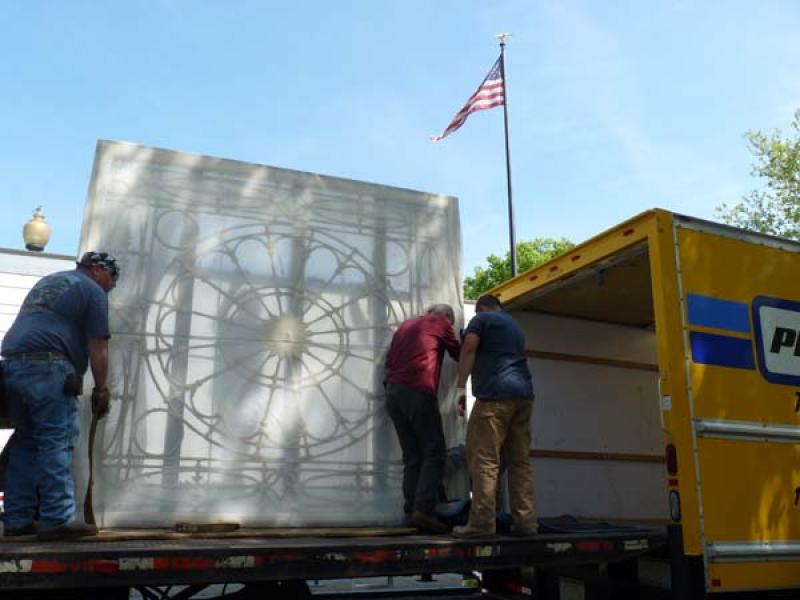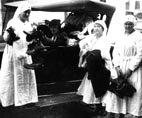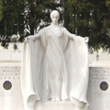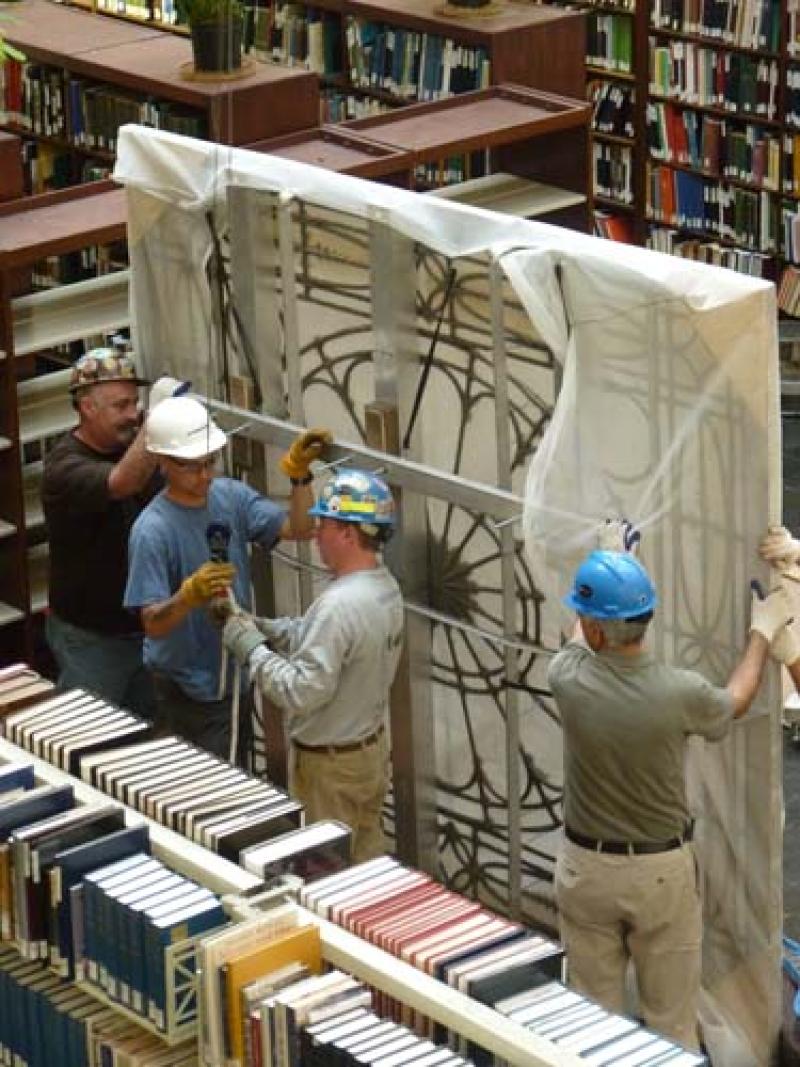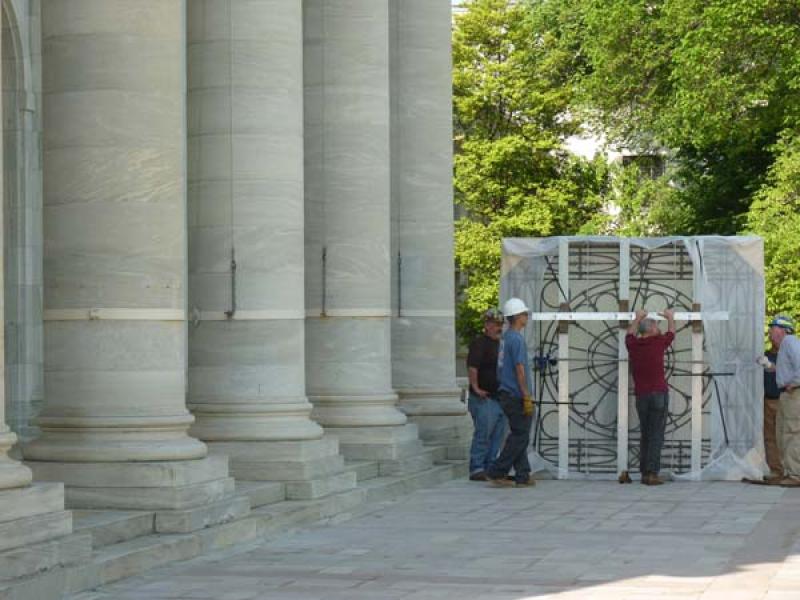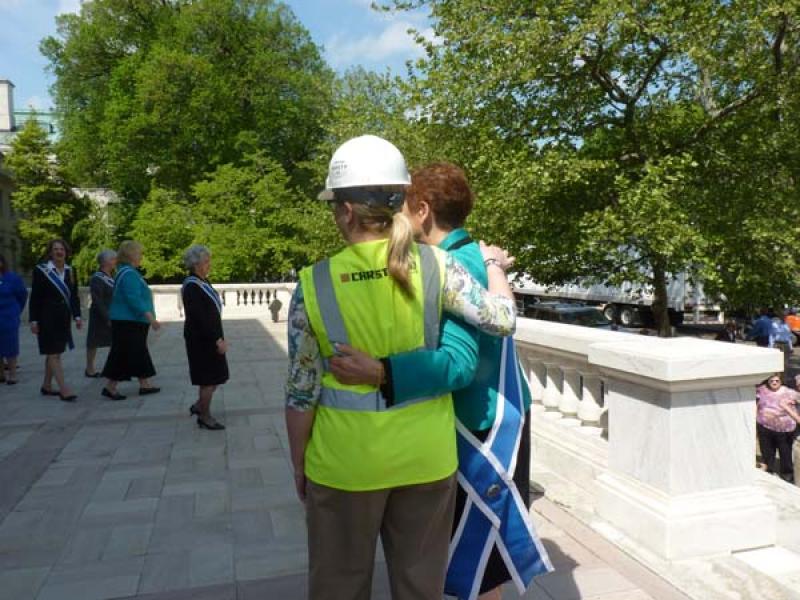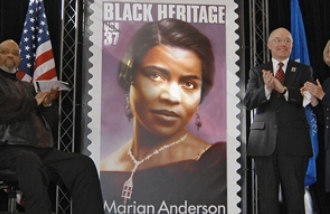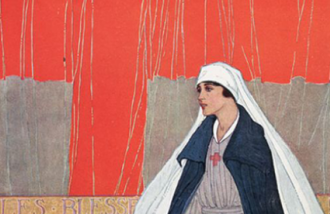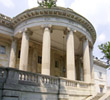As an important first step in the restoration of the historic DAR Library lay light, one initial panel was chosen to be removed in order to learn more about the panel itself as well as the process of removal. The panel selected for removal is visible in the top row of this photo. It is the second panel from the left, next to the dirty center panel.
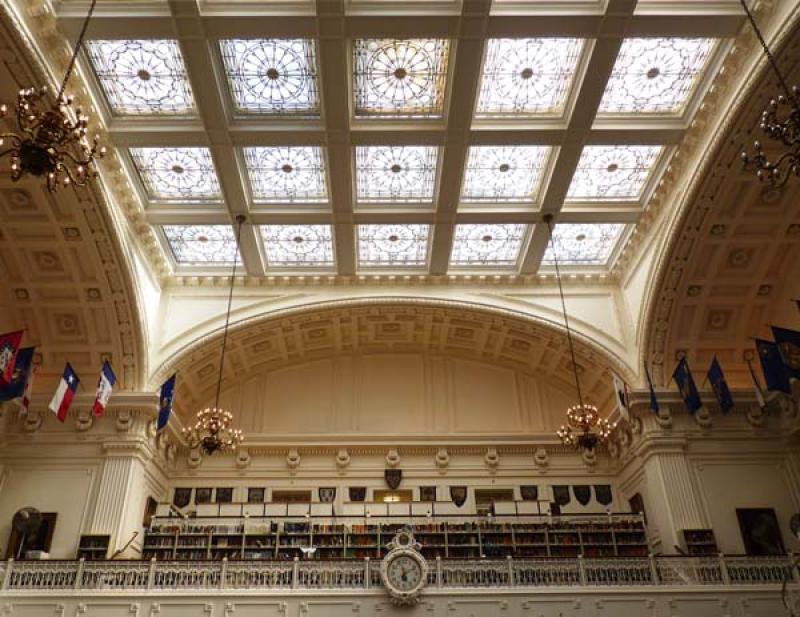
Specialists from United Rigging make plans for how the panel will be raised from its holder and then lowered through the opening. As you can see in the photo, the attic area is a small, challenging work space. United Rigging has experience in handling such large and delicate historic pieces, including many Smithsonian artifacts as well as the Statue of Freedom atop the U.S. Capitol.
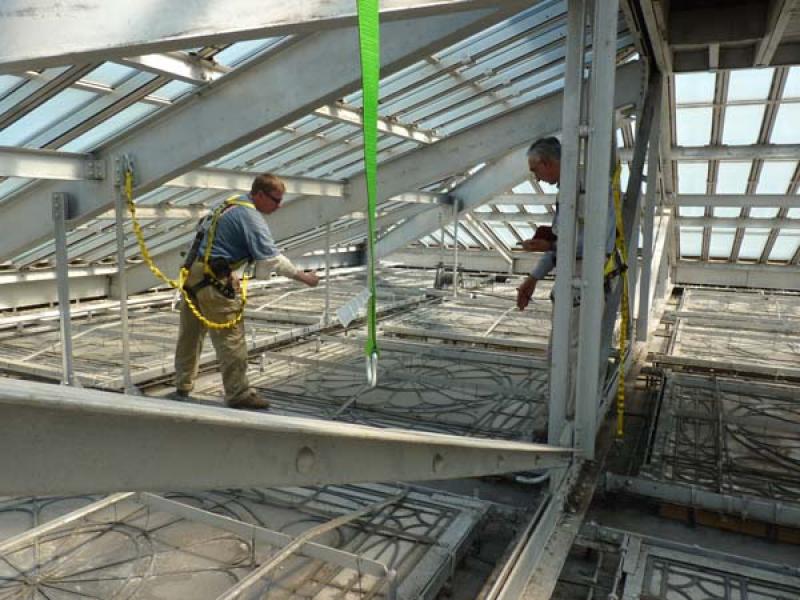
Materials brought in for the lay light panel removal had to be lifted onto the roof by a crane.
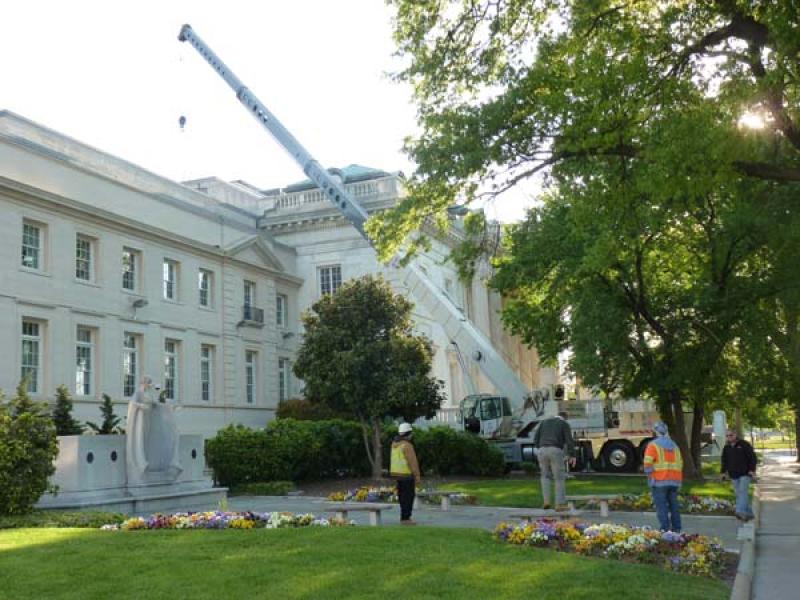
These steel beams and wood boards, along with other essential tools, all had to be transferred through the 24-inch-square hatch entrance to the attic space.
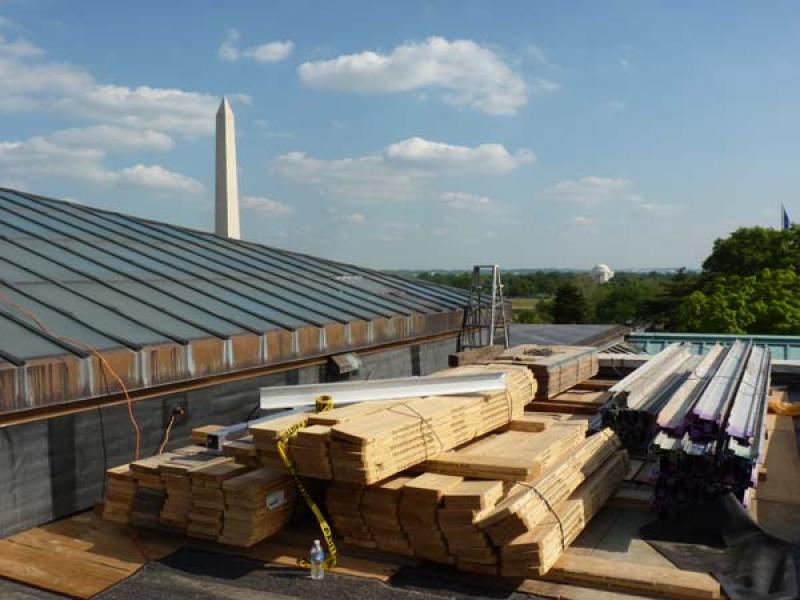
Time lapse digital cameras were installed in the attic space as well as in the DAR Library in order to document the process of removing the lay light.
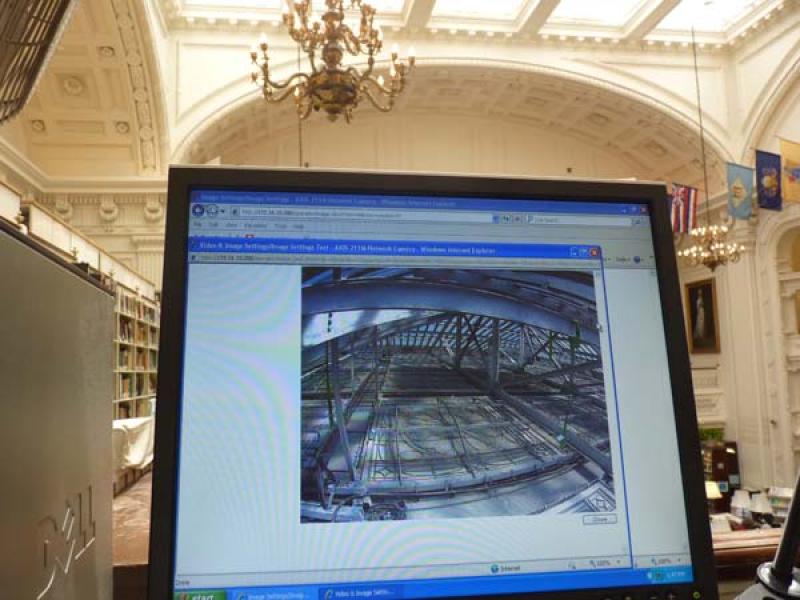
You can see by the dark L shape over the panels how the rigging crew created a platform work area in the attic.
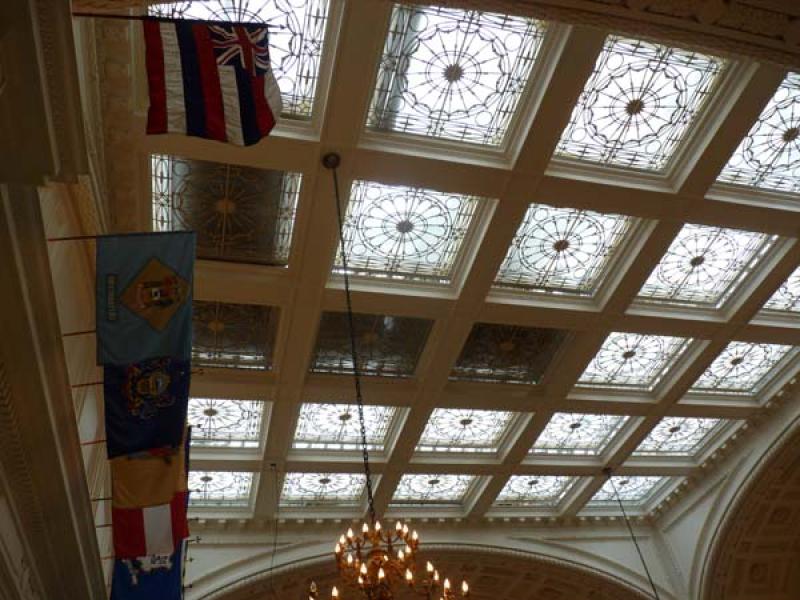
The lay light panel to be removed (center of photo) was lifted out of the steel holder and set atop wood boards to prepare it for lowering. The panels have never been adhered to the ceiling structure but rather just set within the steel frame that holds them in place.
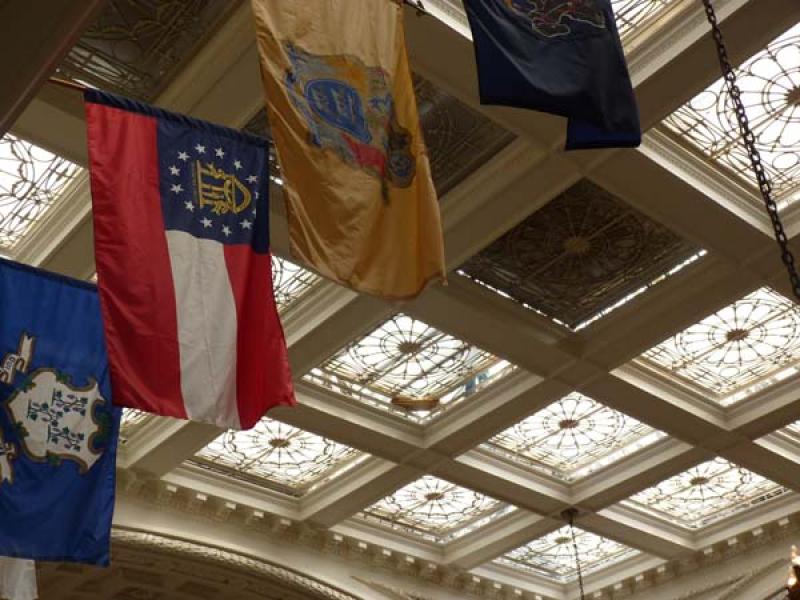
Tables and bookshelves from the DAR Library needed to be cleared out of the way to create a space on the floor to receive the panel once it was lowered.
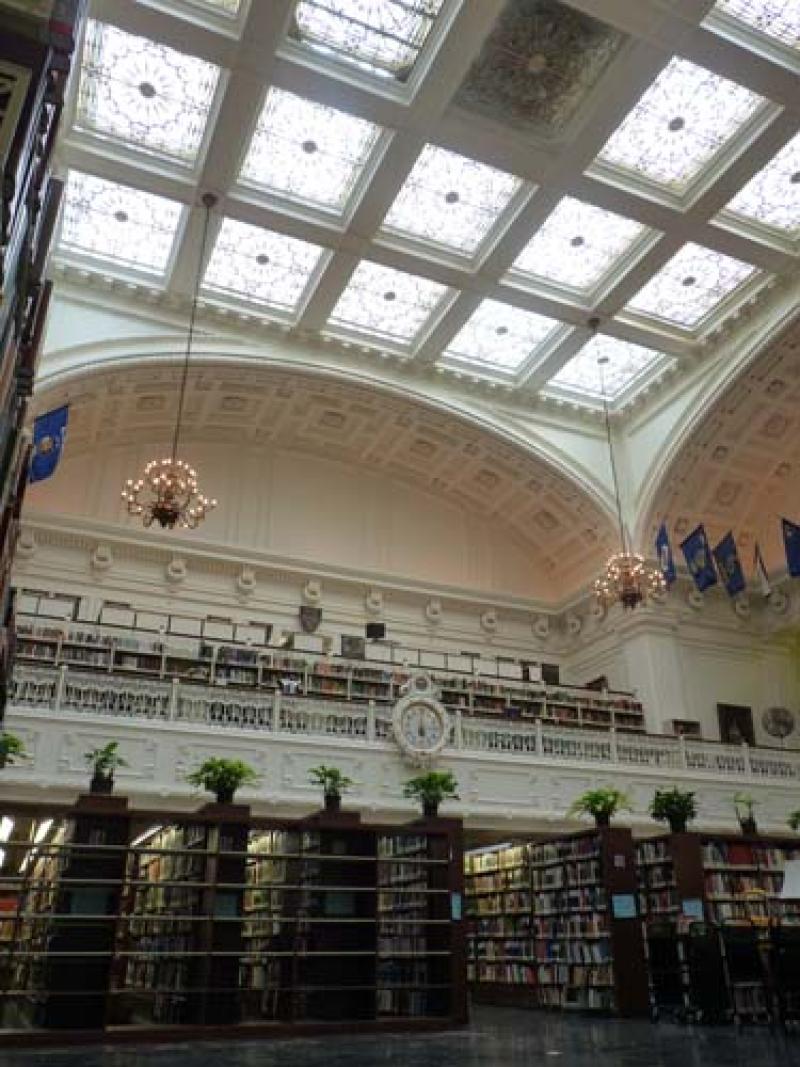
Here you can see the shadows of the three aluminum beams that were attached to the panel in order to reinforce its structure and attach the pulley cable that moved it.
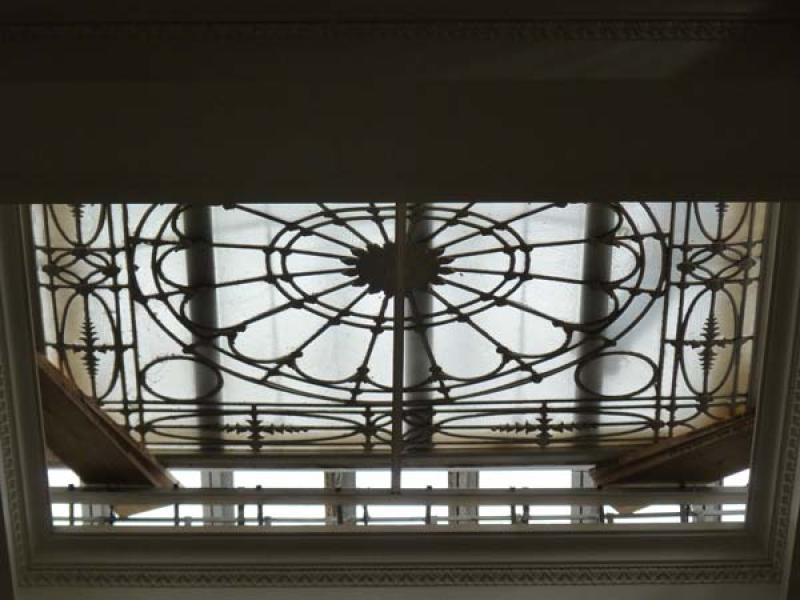
Steel beams were placed atop the steel brackets of the lay light structure and the wood boards placed atop them to create this walkway and workspace in the attic. The industrial exhaust fans brought in only mildly helped decrease the heat in the attic, which was probably upward of 90-100 degrees.
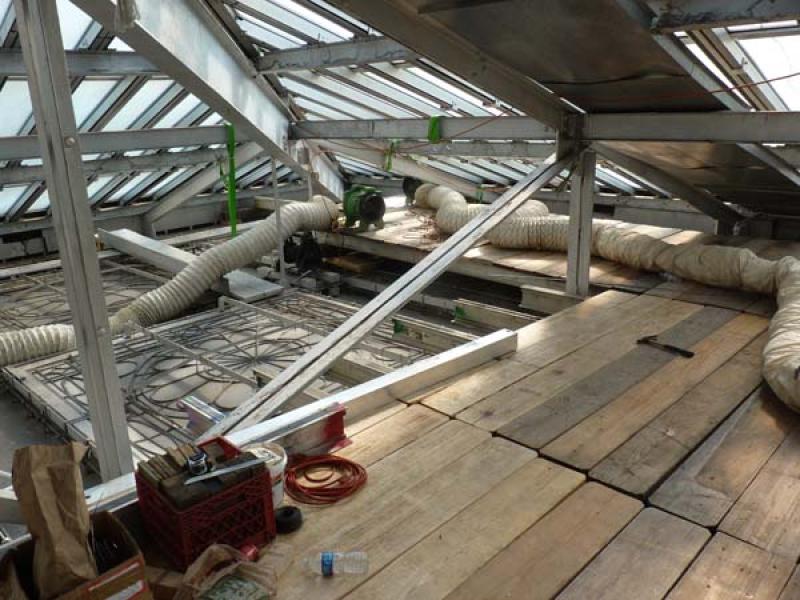
The efficient pulley system was attached to existing and specially placed steel bars within the attic.
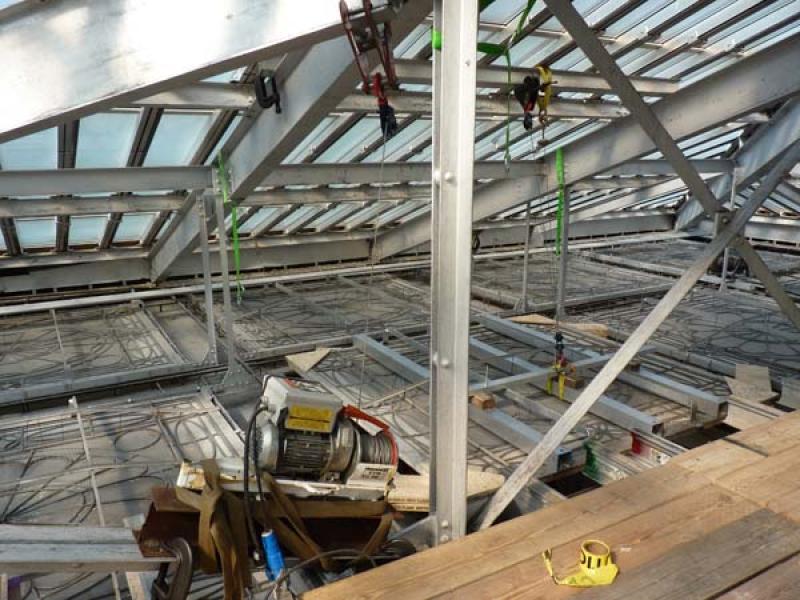
The historic glass expert on site as a consultant made sure that the corners of the lay light were reinforced before lifting. You can see in this photo that the juncture of the original wood beams was loosening (see the slight gap opening in the wood frame?).
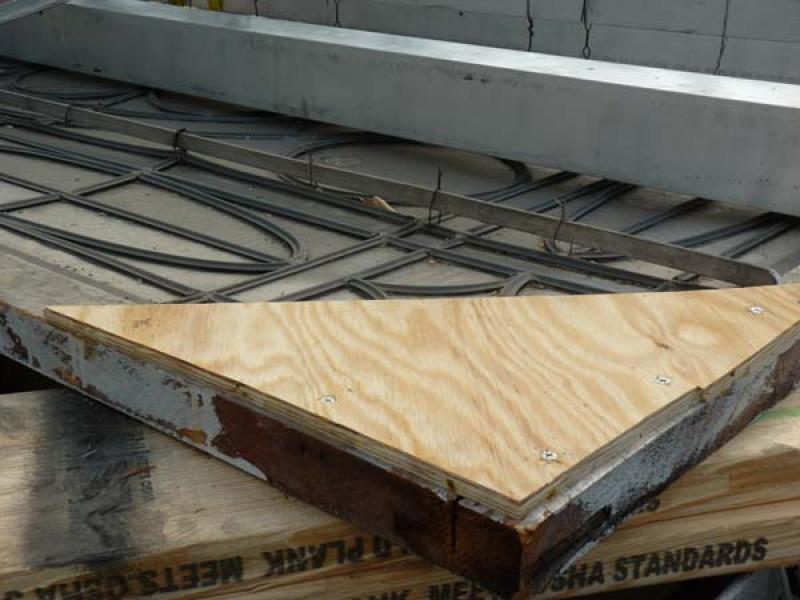
The three aluminum bars were screwed into the wood frames for reinforcement and also to support a perpendicular aluminum bar to which the pulley would be attached.
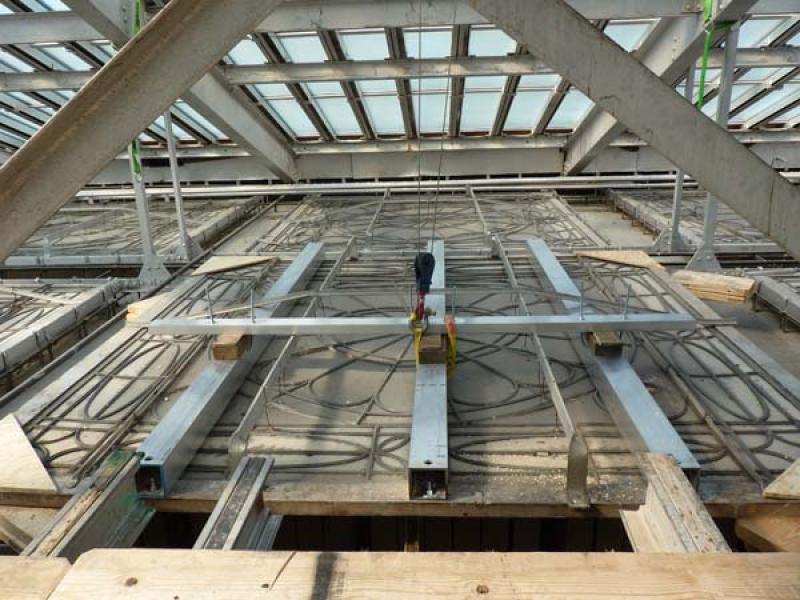
Prior to lowering, protective netting was placed around the panel to catch any glass or decorative elements that may come loose during the movement.
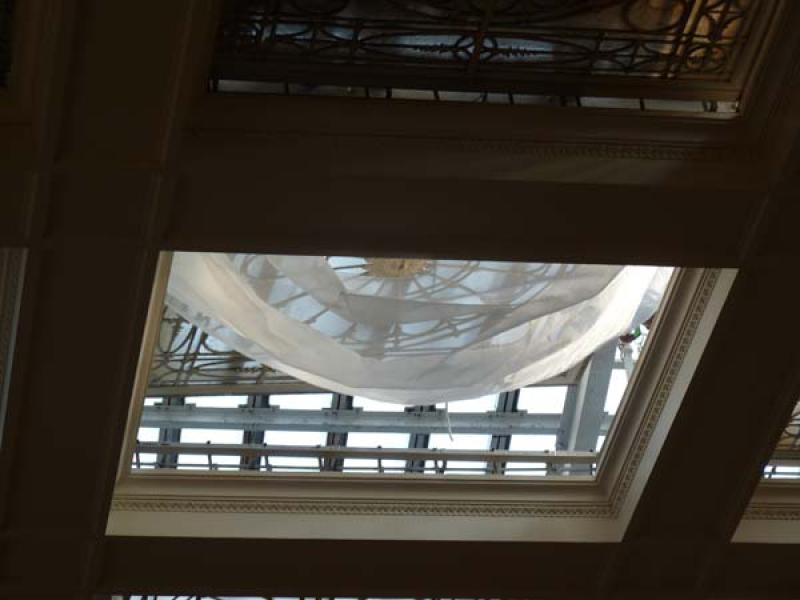
The pulley raised the panel about three feet to start the process of rotating it to fit through the opening. A crowd starts to gather on the lower balcony to watch.
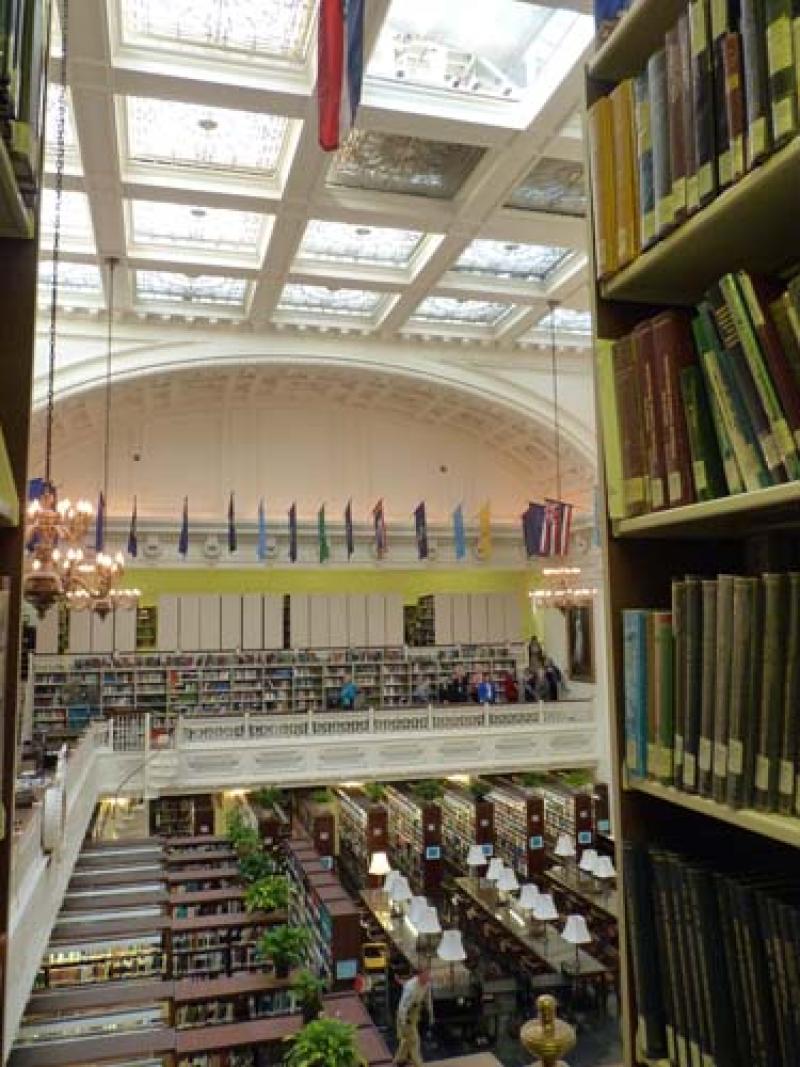
Workers carefully rotate the elevated panel and take measurements to confirm the best angle to maneuver the panel through the opening.
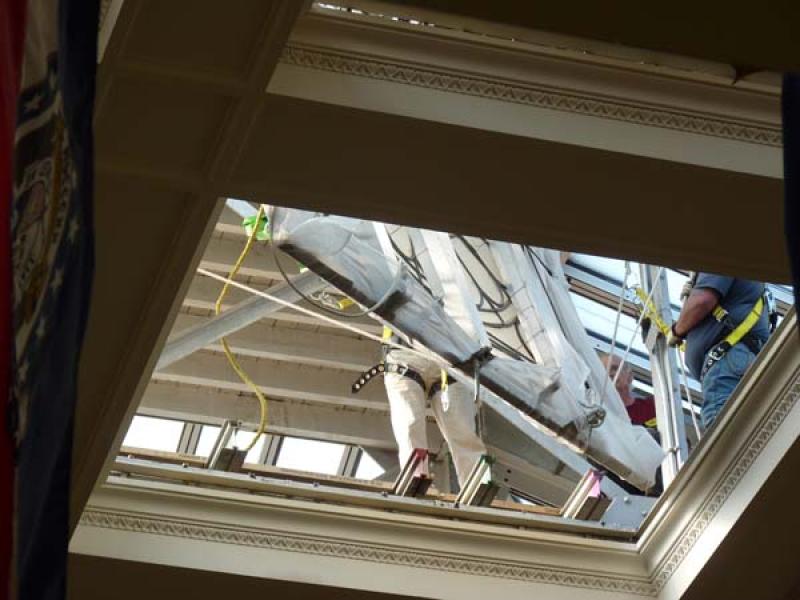
The lay light panel descends from the ceiling of the DAR Library. This is the first time the lay light panel has been moved in more than 100 hundred years, when it was first put in place in the newly built Memorial Continental Hall.
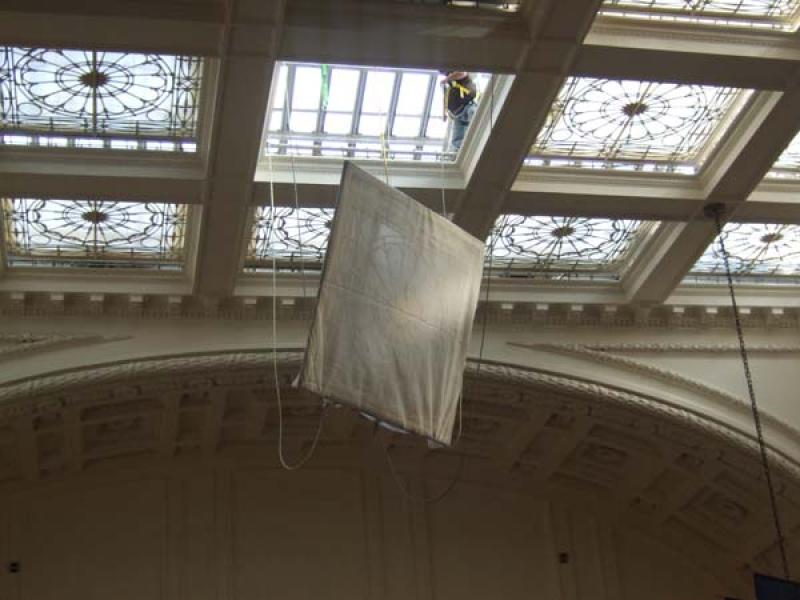
The panel was carefully, but relatively quickly, lowered by a mechanical pulley system, and stabilized by attached ropes from above and below.
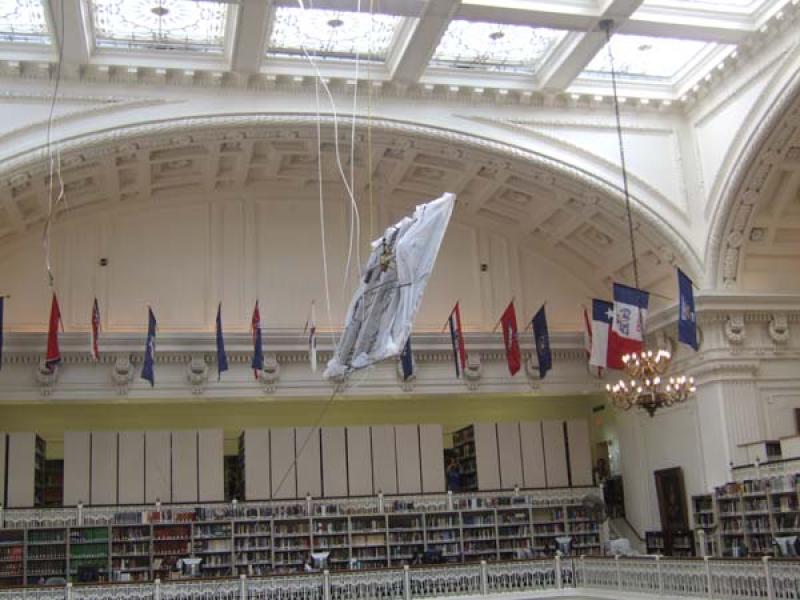
The Executive Officers and other onlookers watch the historic lowering of the lay light panel.
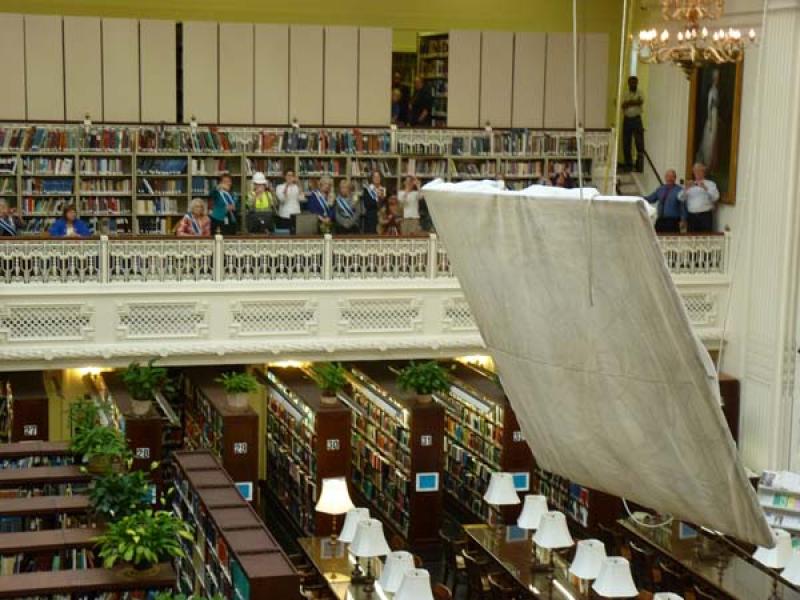
The lay light panel successfully reaches the floor of the Library, where it remained hovering until workers could stabilize it.
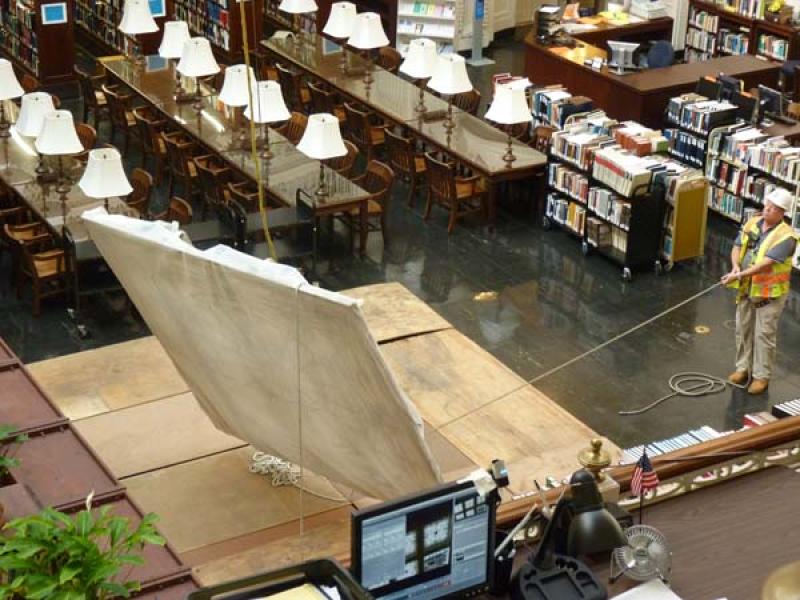
Workers examine how the panel handled the movement. The lay light panel proved to be structurally sound enough to withstand being lowered to the ground without any additional damage.
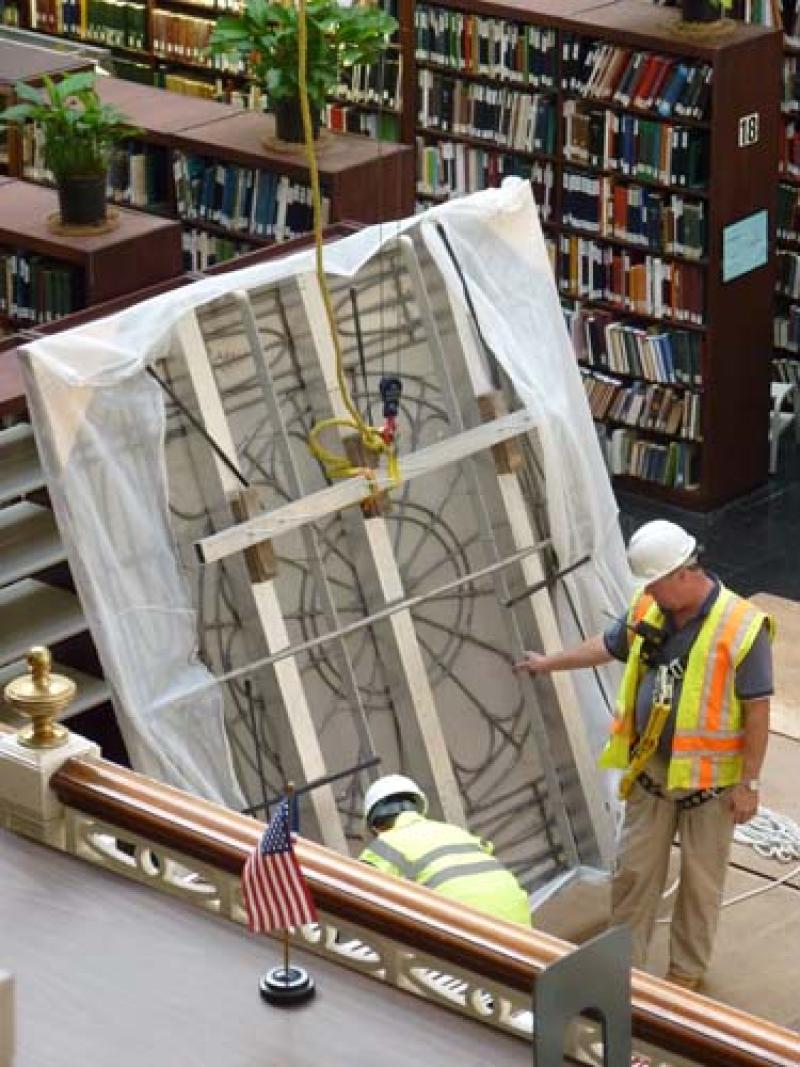
The lay light panel was lowered almost 50 feet to the floor of the Library.
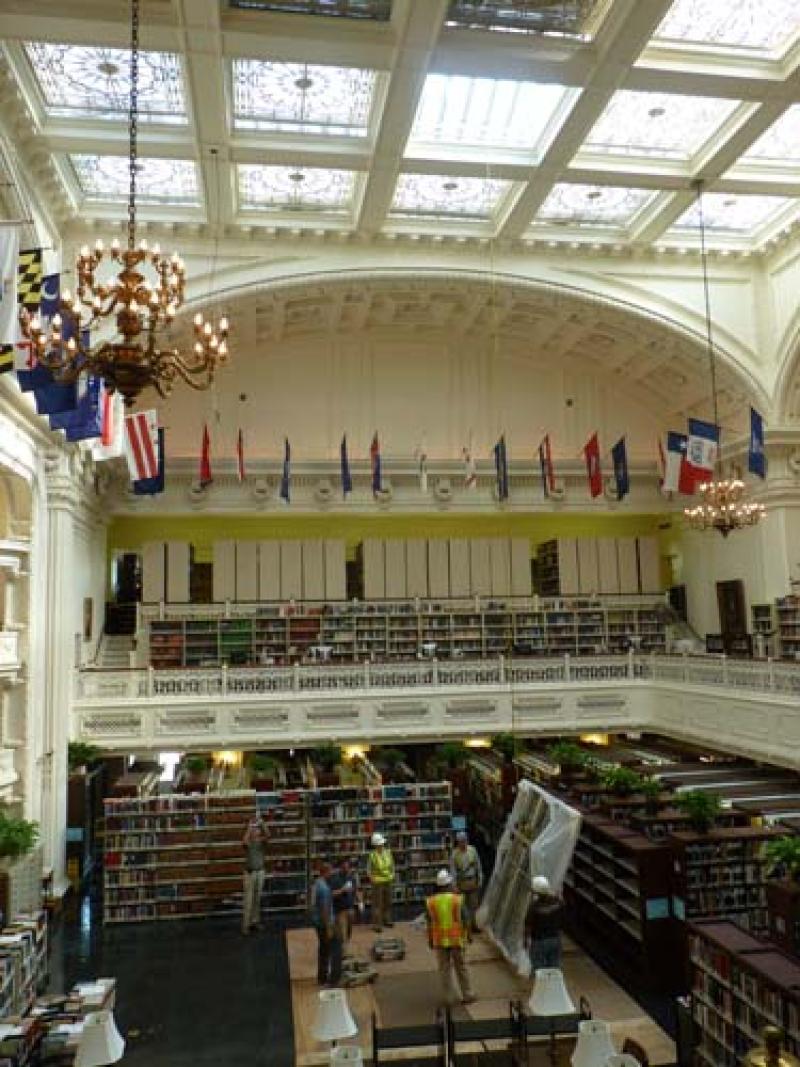
President General Merry Ann Wright was very pleased after the successful lowering of the first lay light panel.
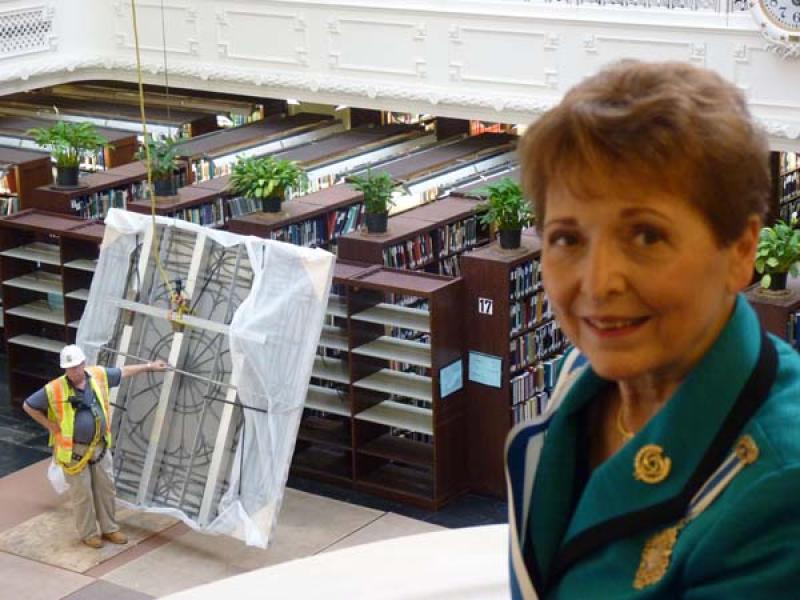
After the panel was lowered, the next challenge was to get it out of the building. The only feasible exit path with enough height clearance was through the bookshelves and Genealogy Department and out the French doors that lead to the North Portico. You can see at the left of this photo that the crew had to remove the lights from one of the bookshelves in order to have enough height clearance.
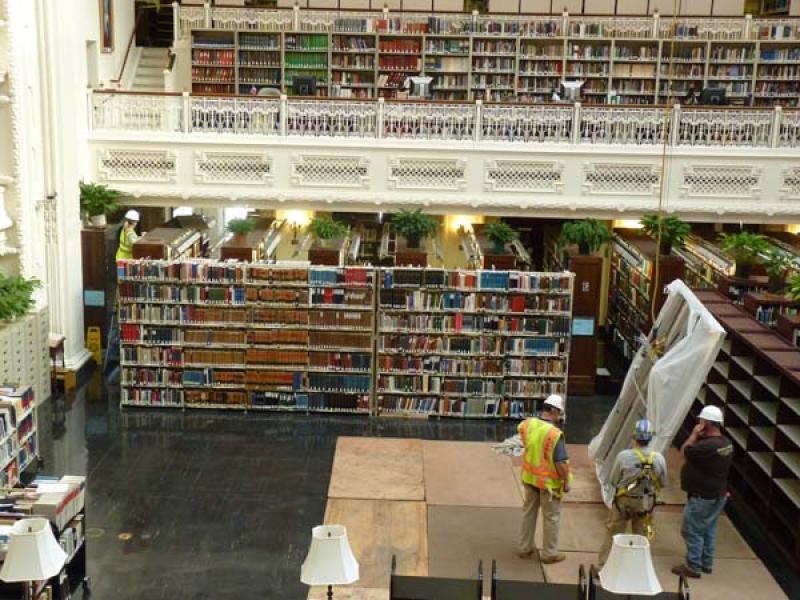
Space was tight along the exit route because some of the bookshelves are permanently affixed to the ground.
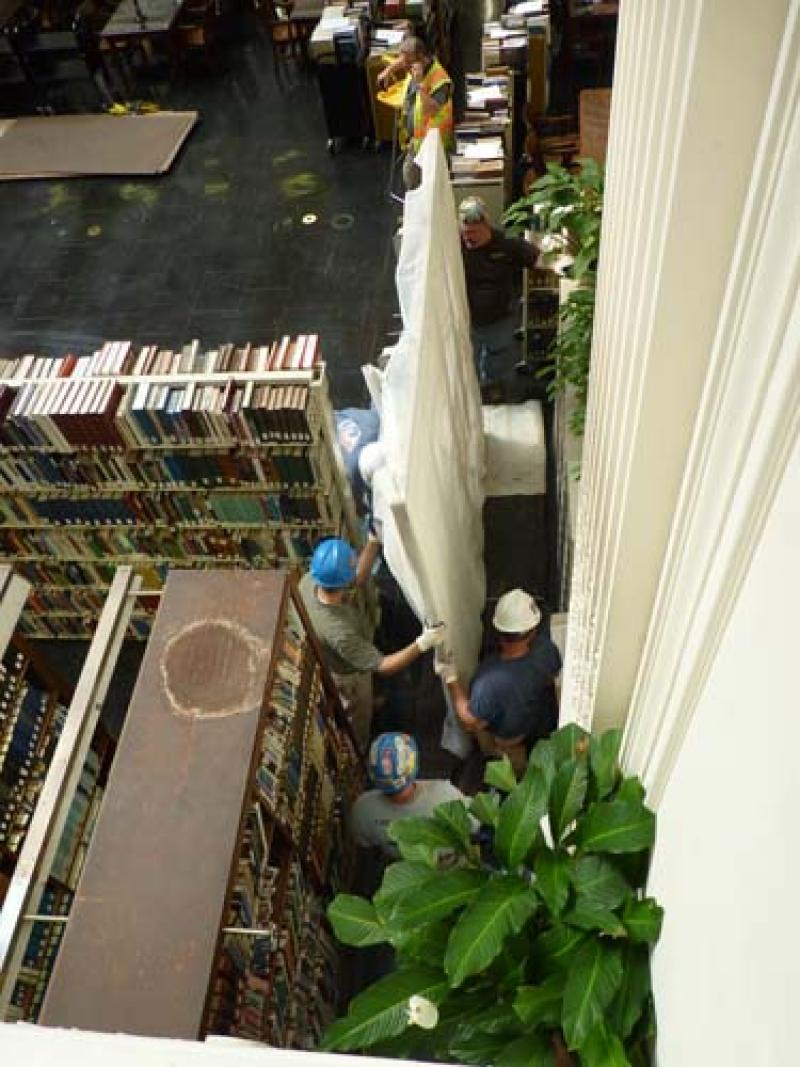
The workers were able to slide the lay light panel on blankets over the hard floor.
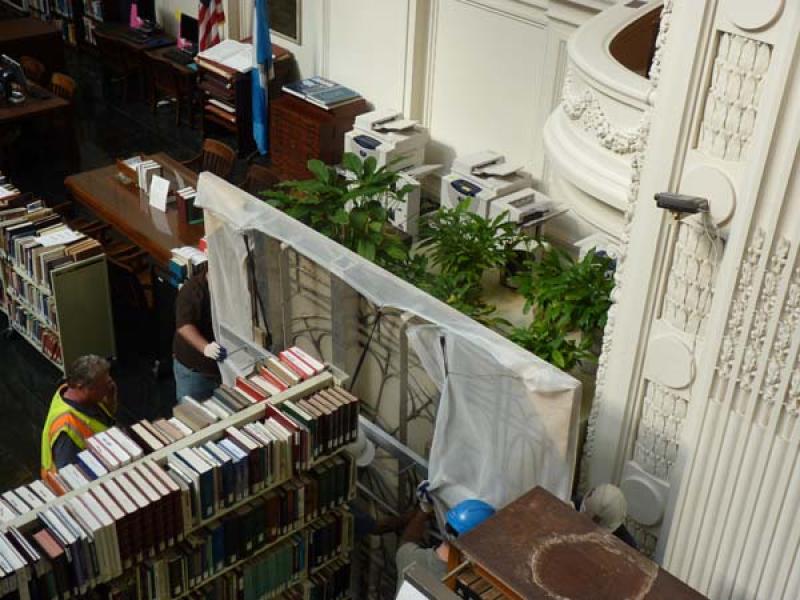
The Genealogy Department got a good view of the panel working its way through their office on its way out the doors that lead to the North Portico.
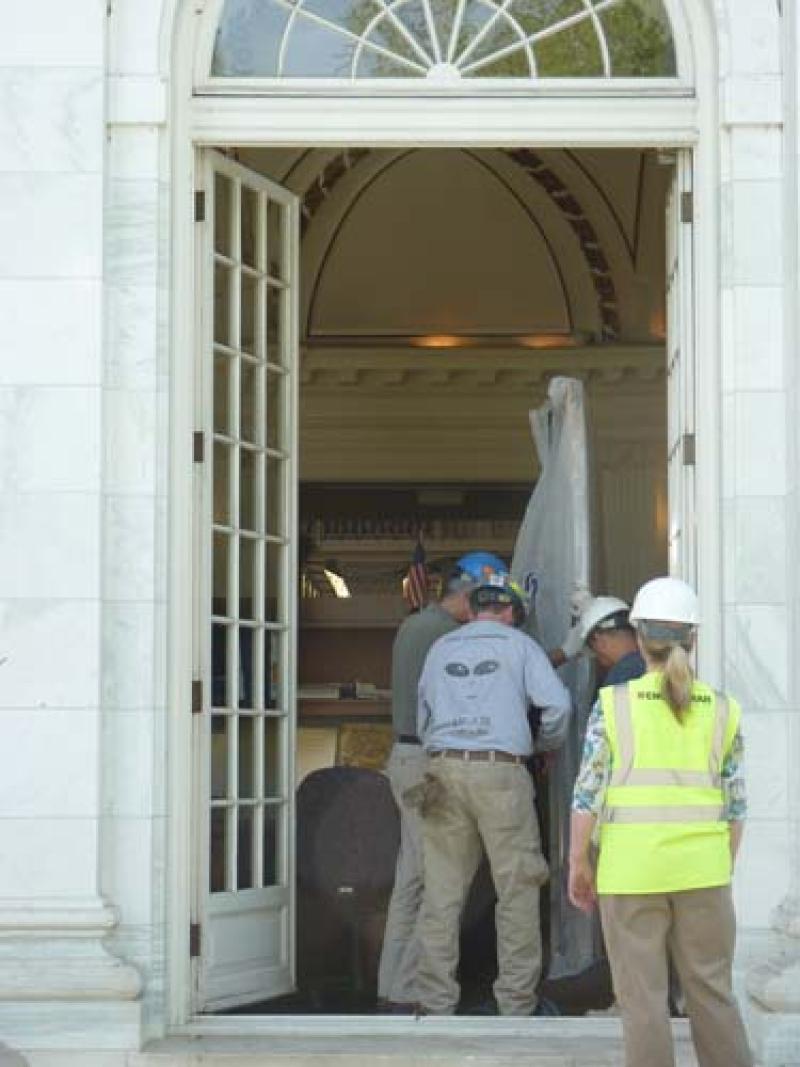
The workers had to lift and carry by hand the 400 pound lay light panel – which actually weighed almost 500 pounds with the additional aluminum added to it.
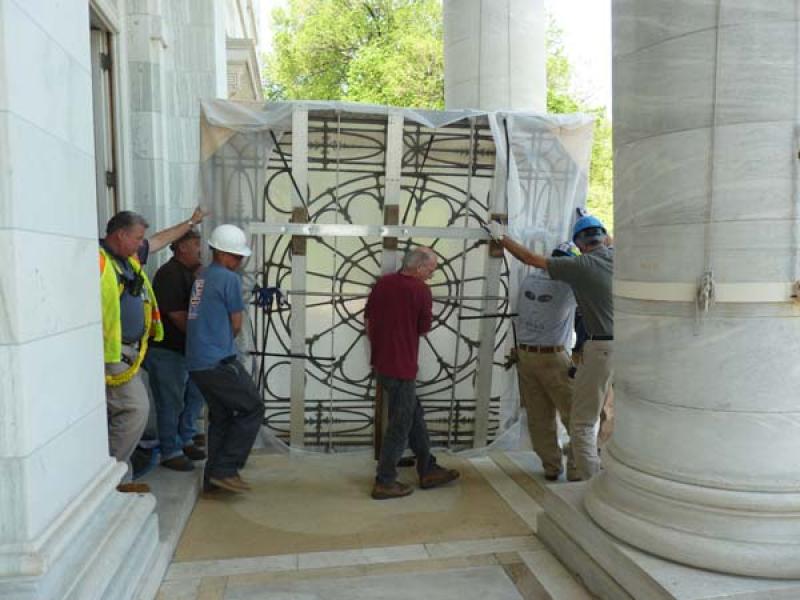
The workers carried the panel by using these straps to hold it from the bottom.
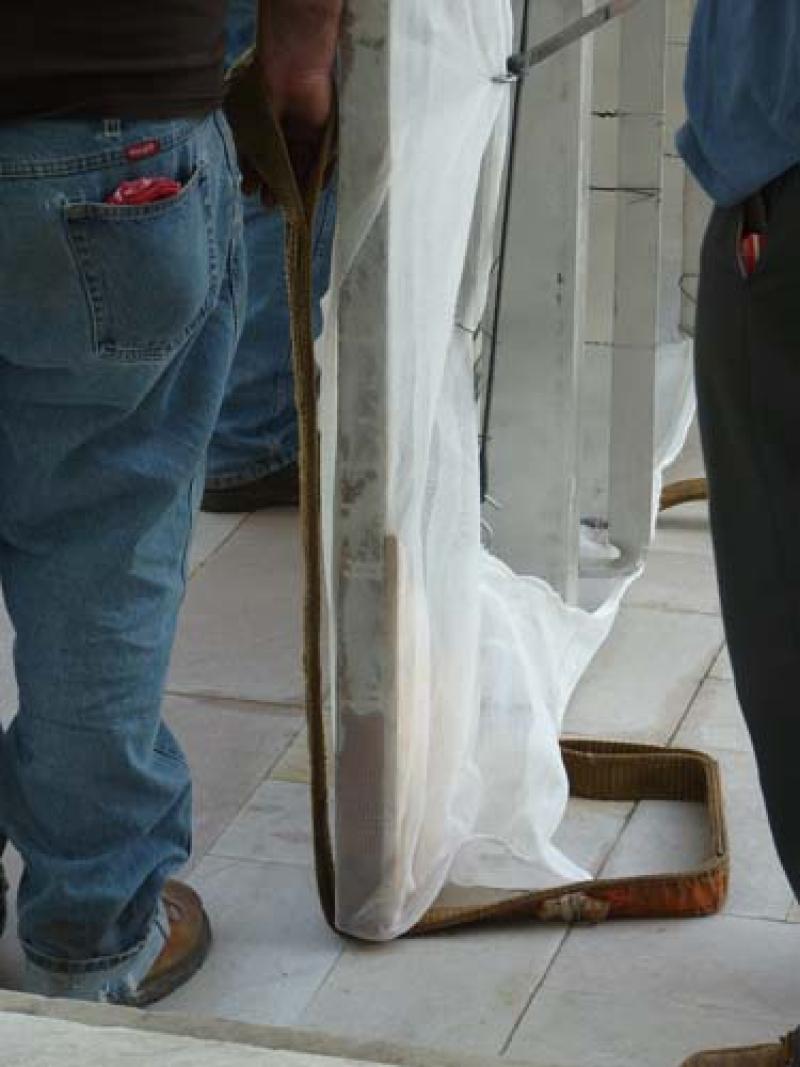
One of the decorative ornaments from the lay light panel did get jostled and fell off during the initial lowering.
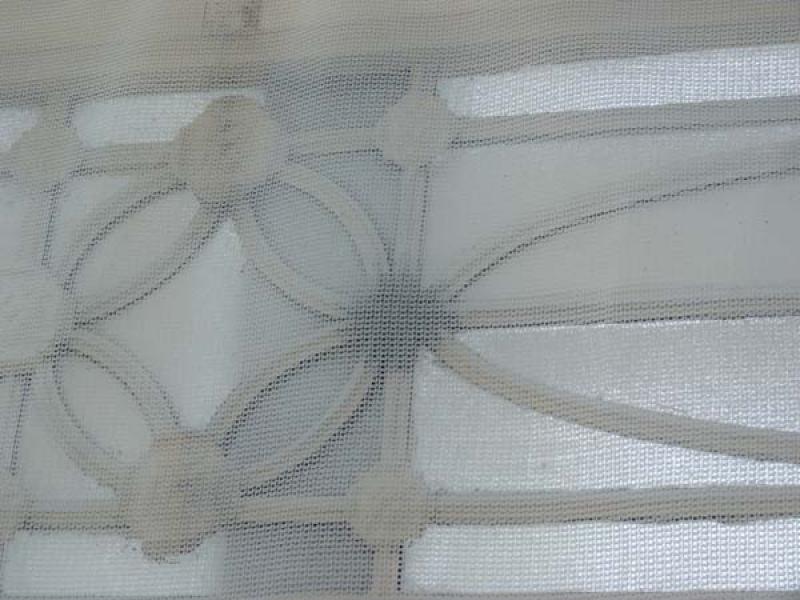
The decorative ornamentation that fell off during the movement was caught by the protective netting. That was the only piece that came off the panel during the move.
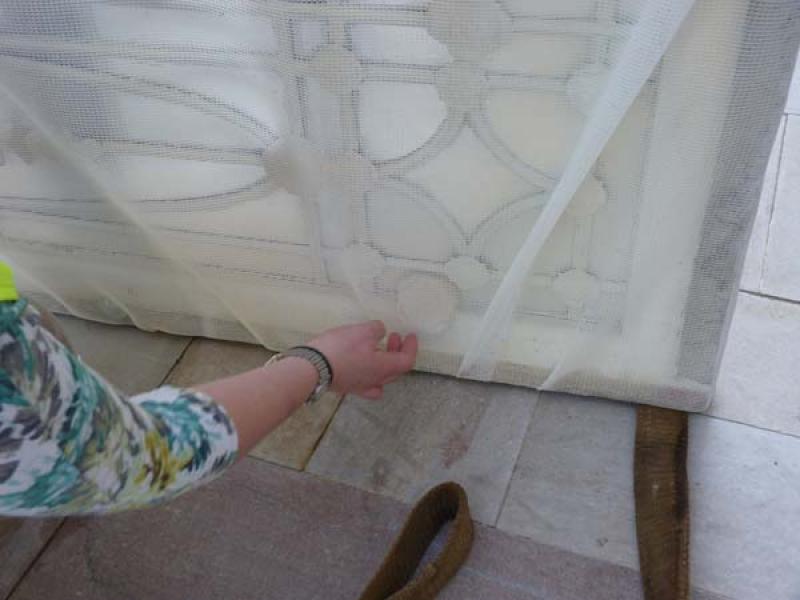
The panel sits on the North Portico of Memorial Continental Hall awaiting transport to the glass conservation facility where it will be closely examined.
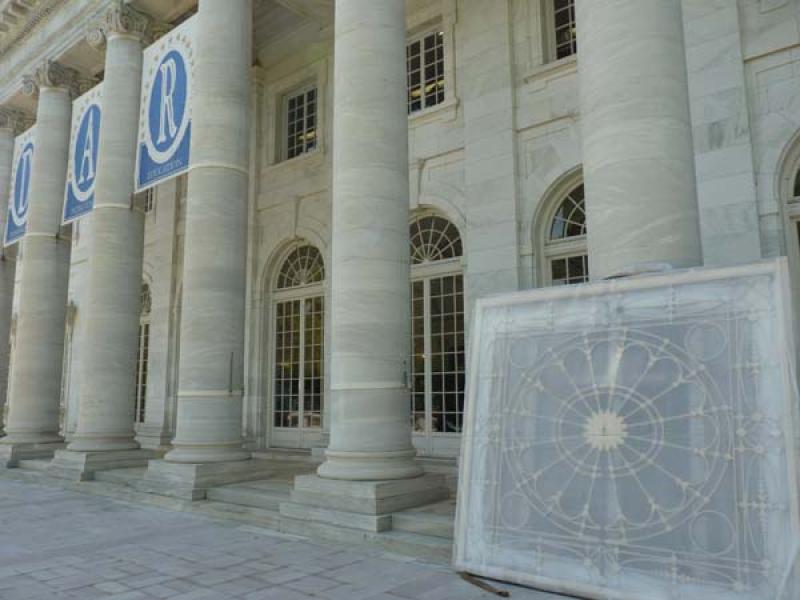
The truck which will transport the lay light to New Jersey arrives.
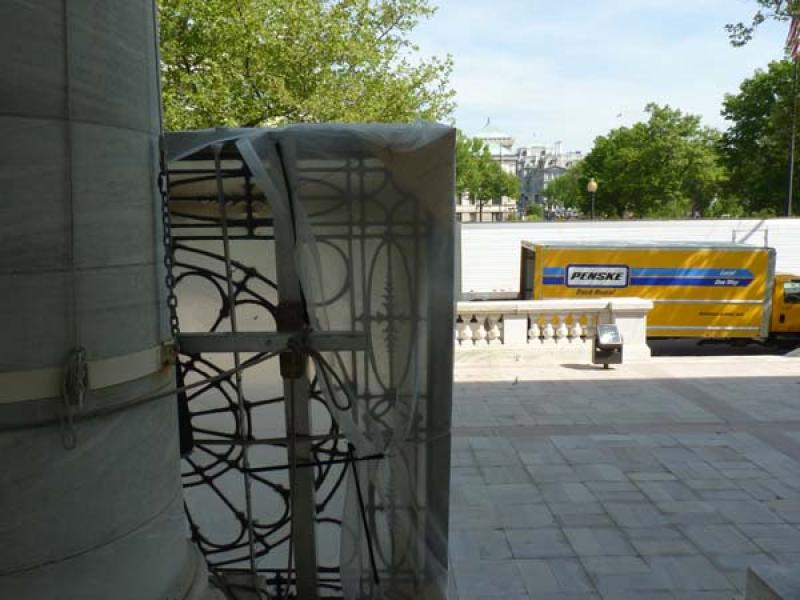
Being able to get close to the lay light, you can see even more clearly the evidence of deterioration. This is an example of where an improperly placed wire has pulled the zinc came away from the glass and is starting to break.
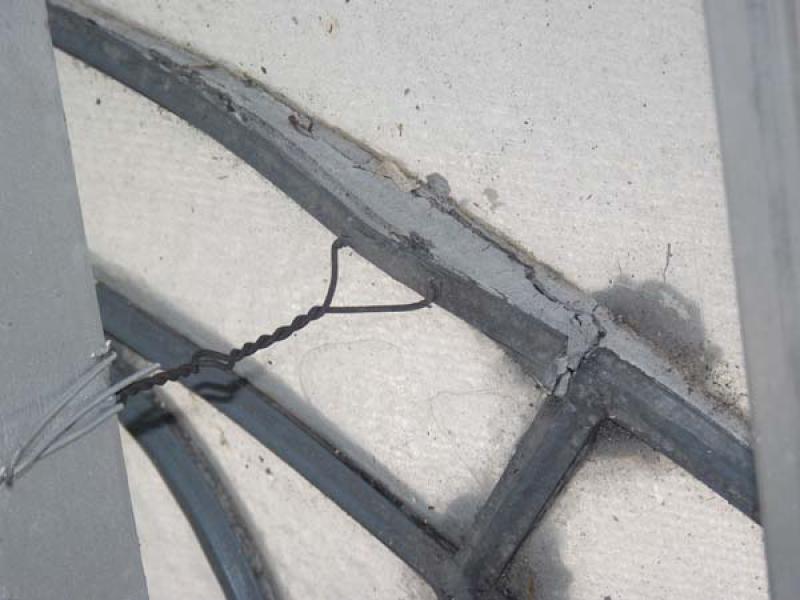
At the top of this image you can see where paint overspray has covered the outer rim of the panel.
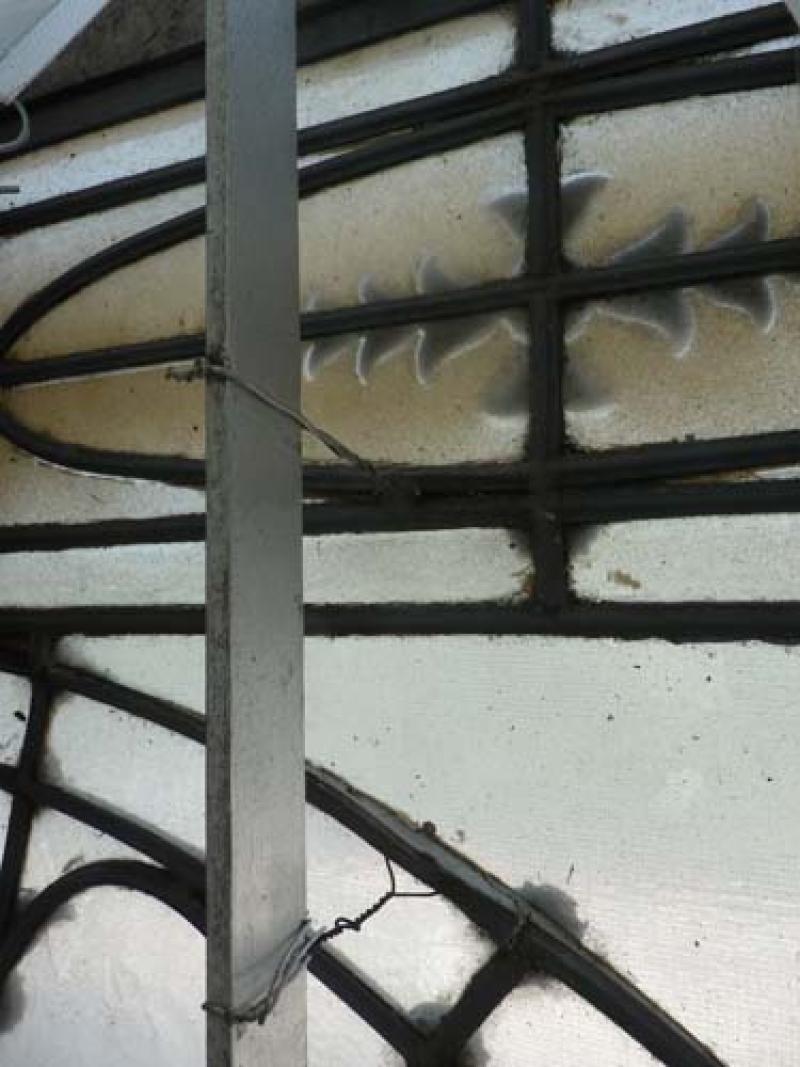
The team from United Rigging who literally did the heavy lifting for DAR.
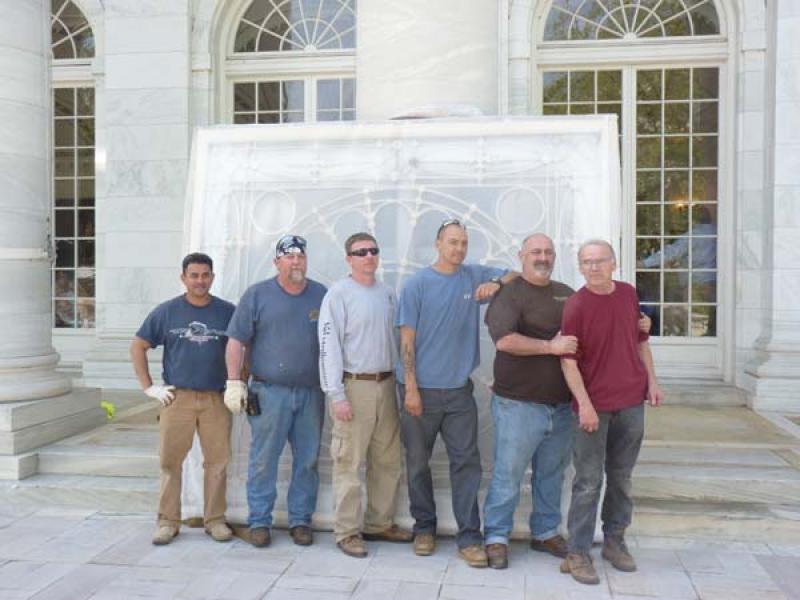
President General Merry Ann Wright gets her first close-up view of the top side of the panel (the side visible only from the attic).
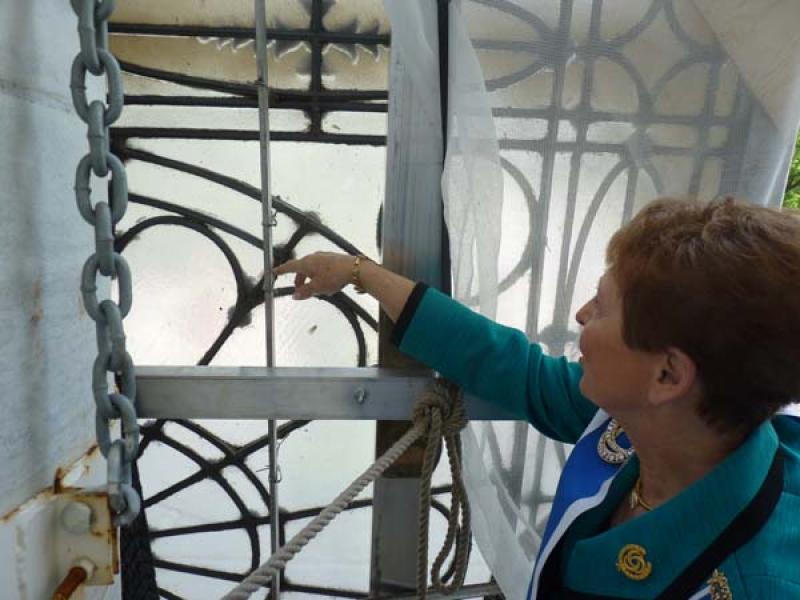
The Executive Officers examine the deterioration of the lay light panel.
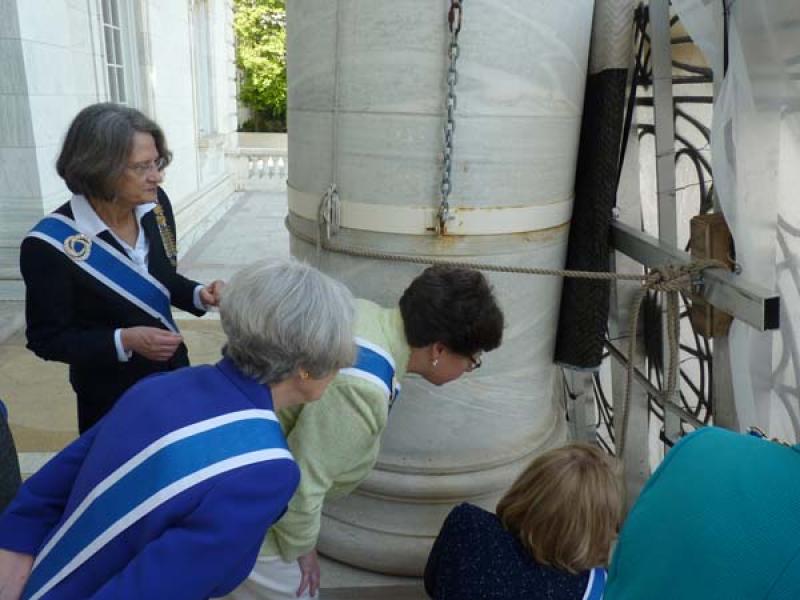
The President General was in awe of being able to actually touch the 100-year-old panel that has only been seen from afar for so many years. With her is the project manager from Christman Company, Jennifer Wallace, who is describing some of the details of the lay light and what the next steps will be.
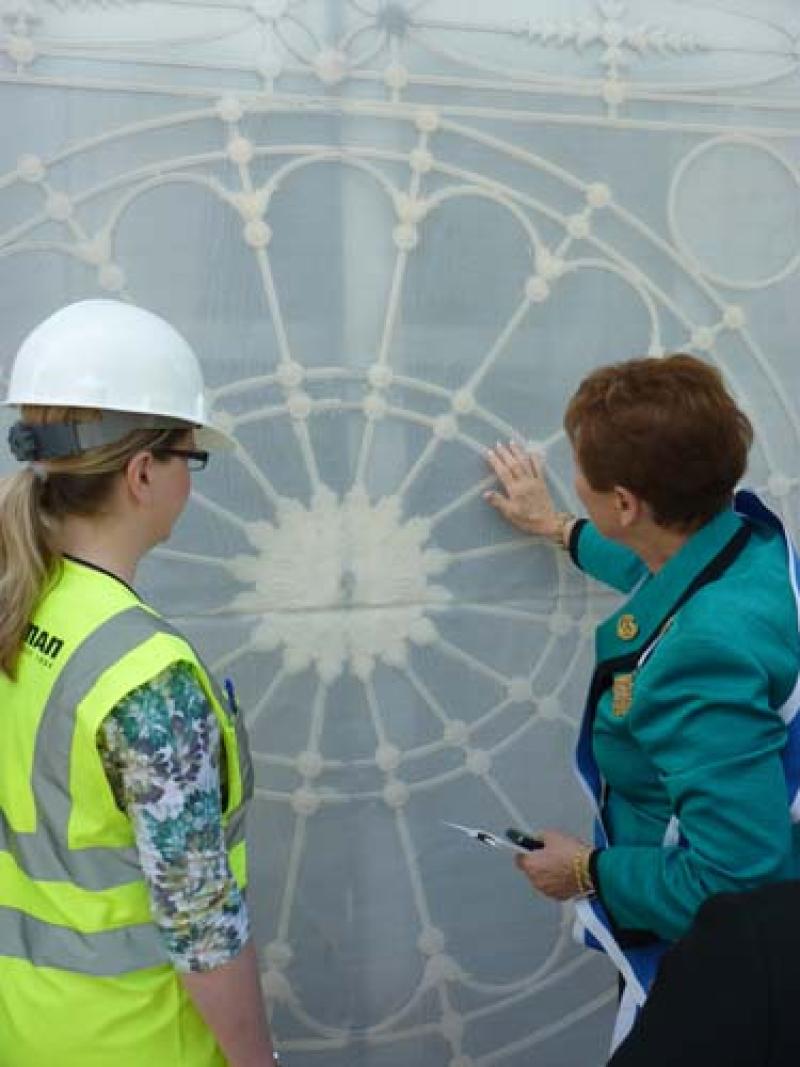
Mrs. Wright thanked the workers for taking such good care of the historic DAR lay light panel during the removal process.
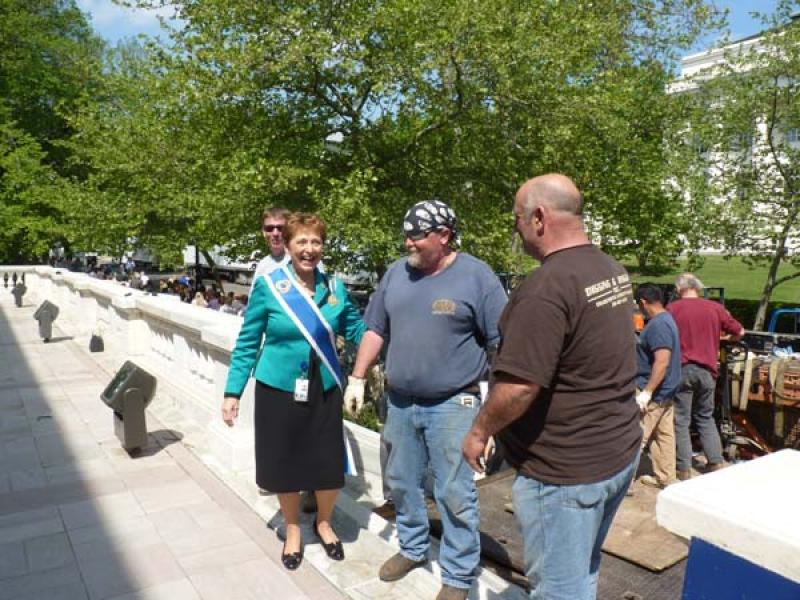
President General Merry Ann Wright and the lay light panel. Funds raised through the President General's Project will go toward the restoration work on the DAR Library lay light, which is anticipated to cost approximately $1.6 million.
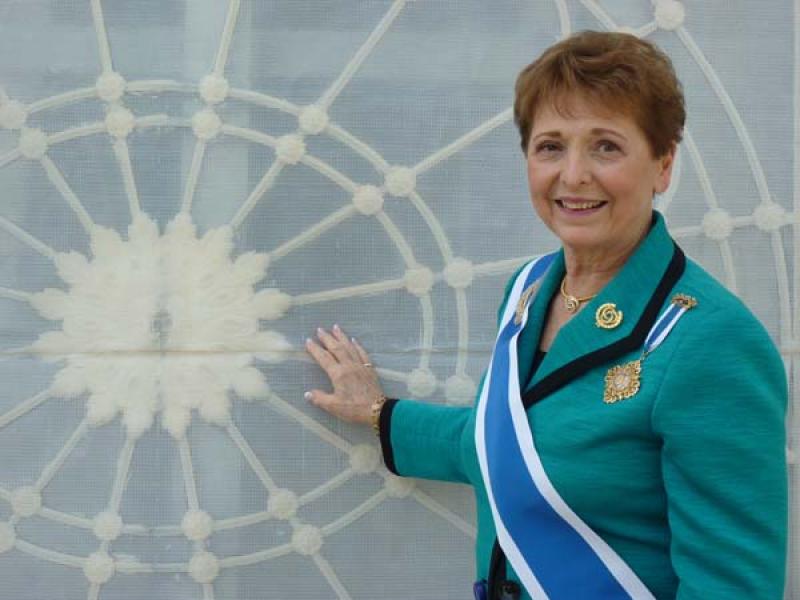
You can get a sense of the immense size of the lay light panel, here with the Executive Officers and National Parliamentarian.
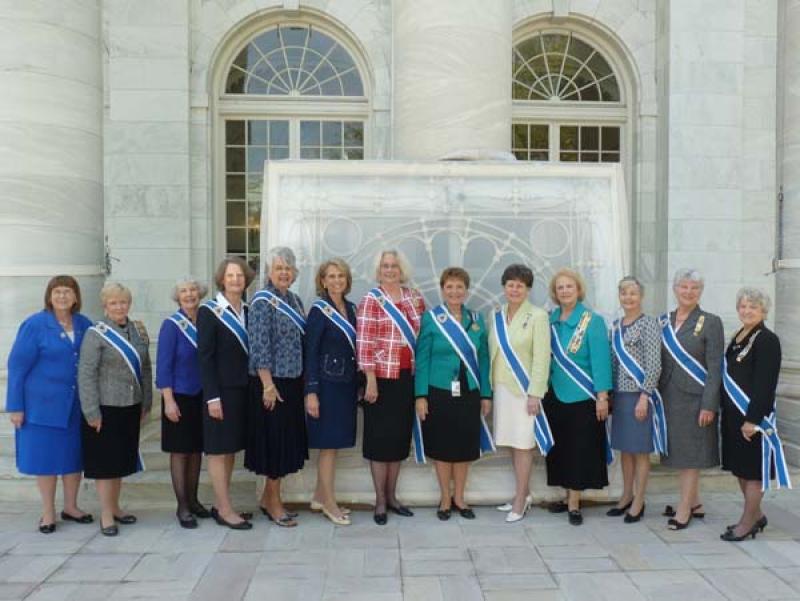
Mrs. Wright is dwarfed by the lay light. The DAR banner flies at half-staff in remembrance of Honorary President General Marie Yochim, who passed away April 19, 2012.
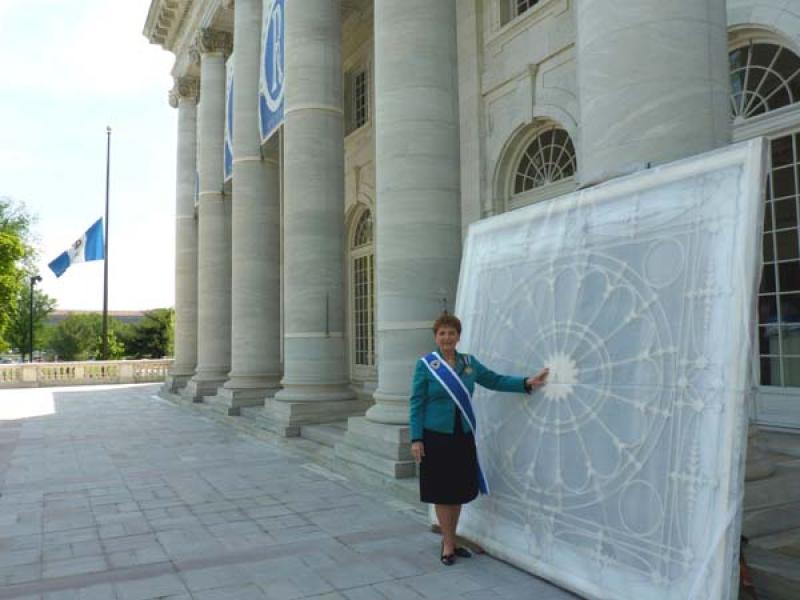
As preparations were made to move the lay light panel into the truck, a large crowd of people lining up to go to the Jeopardy! tapings being filmed in Constitution Hall that day had formed on the sidewalk. The line wrapped all the way around the building
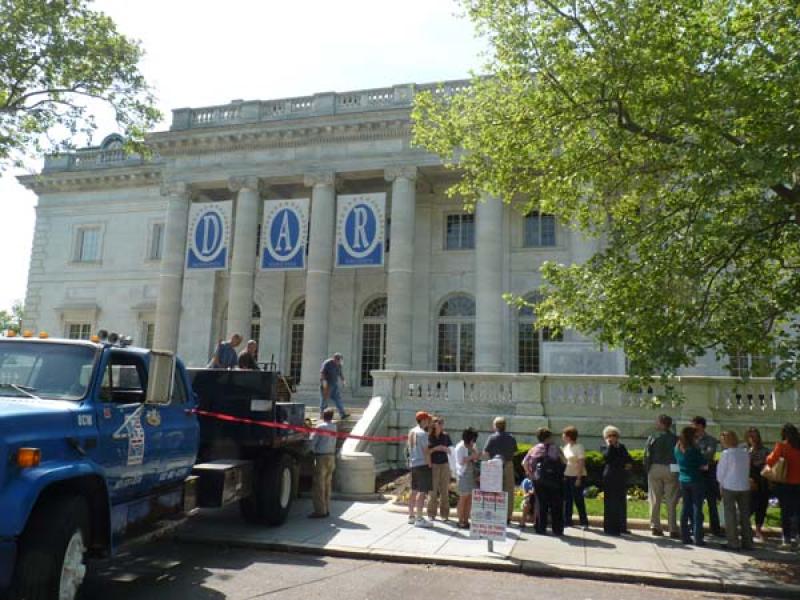
The rigging crew's mechanical flatbed truck was able to be positioned at the top of the stairs to the North Portico. Those waiting in line for Jeopardy! got a front-row view of the lay light excitement.
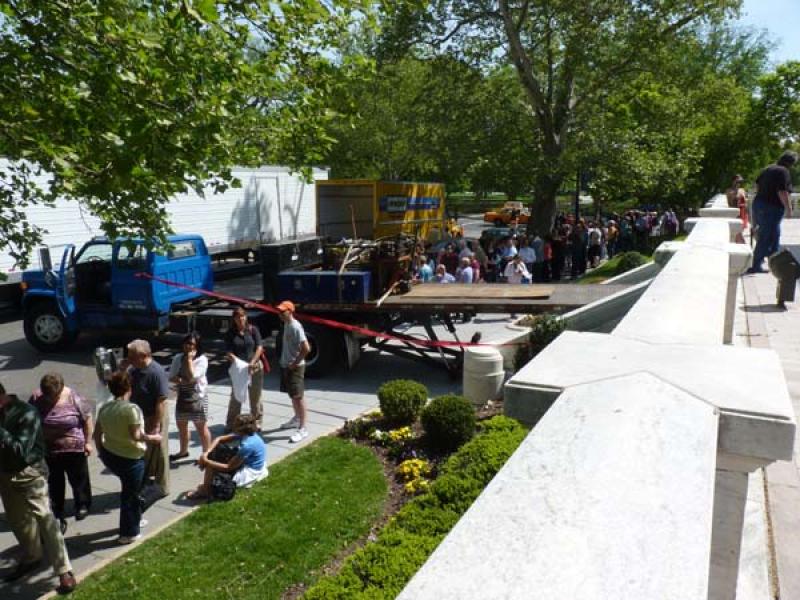
The workers carefully lifted and carried the lay light – 500 pounds of metal and glass – across the North Portico to the truck.
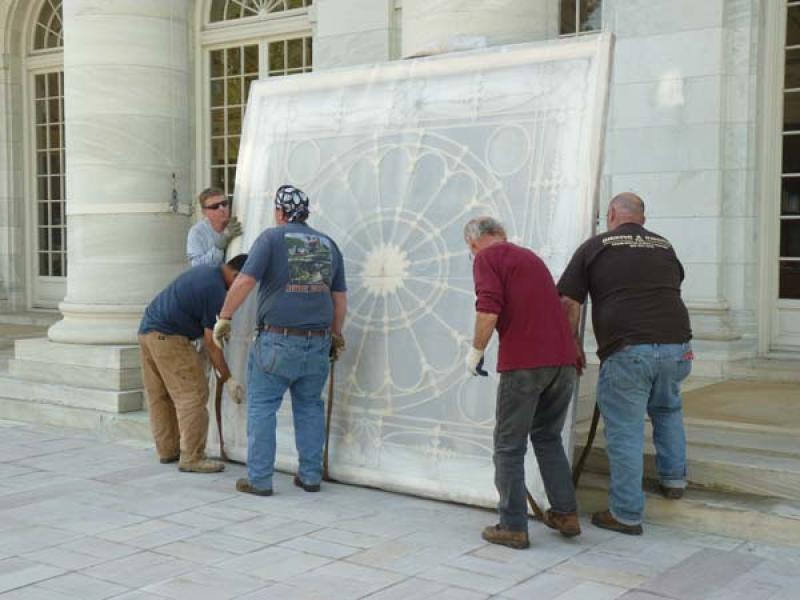
Once the lay light panel was on the truck, the workers needed to stabilize it while the truck moved away from the stairs and slowly backed up to the moving van into which the lay light panel would be transferred .
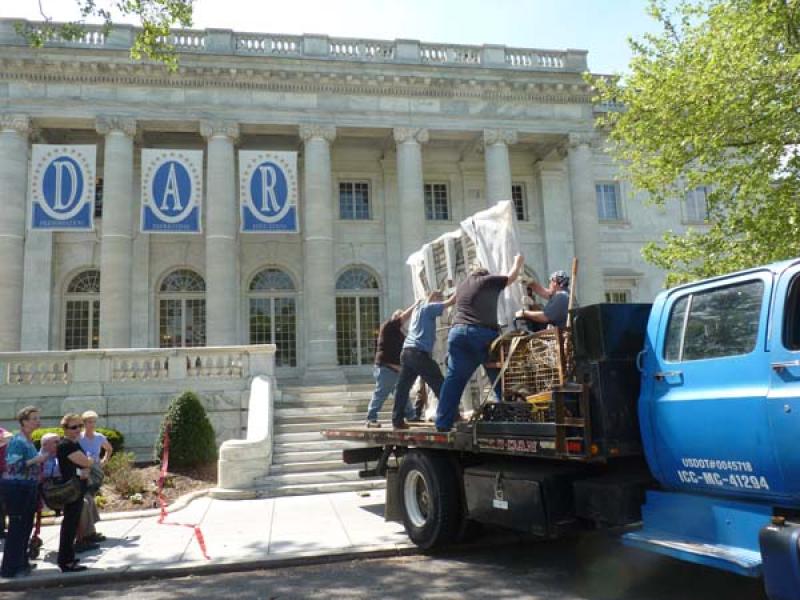
The crowd was enthralled with the activity of the lay light panel and were asking questions.
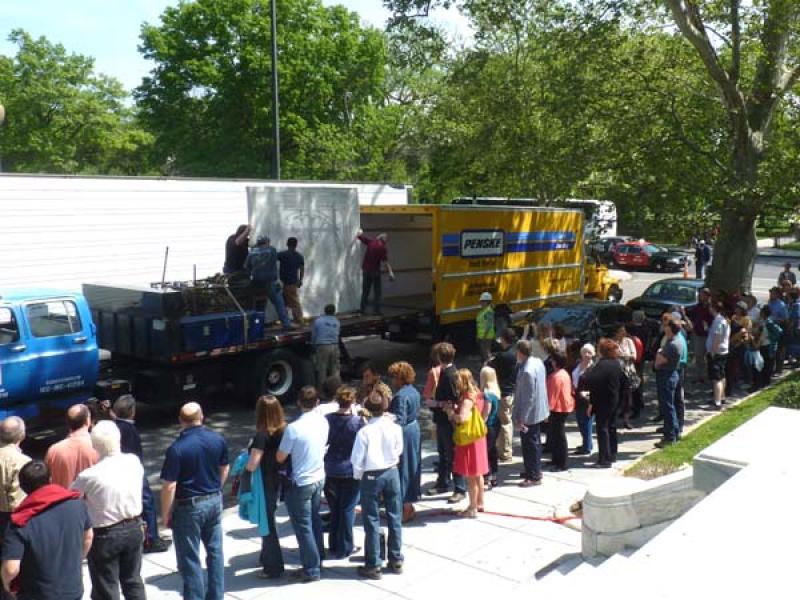
Many in the crowd didn't believe that the workers were going to be able to get the panel through what seemed to be too small of an opening on the moving truck. But the workers were confident that their precise mathematical calculations would prove them right.
